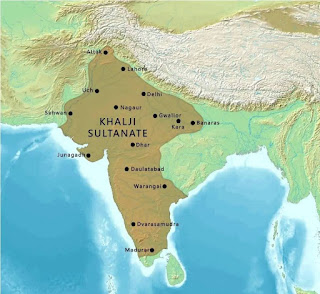Here's a concise, informative blog post on the territory controlled by the Khalji dynasty of the Delhi Sultanate around 1320:
Territory of the Khalji Dynasty Around 1320: Peak of Sultanate Power
The Khalji dynasty (1290–1320 CE) marked a significant phase in the expansion of the Delhi Sultanate, with its territory reaching one of the largest extents under Sultan Alauddin Khalji. By the end of the dynasty’s rule around 1320, the Delhi Sultanate's control spanned vast regions of the Indian subcontinent, thanks to aggressive military campaigns and strategic governance.
Territorial Expansion Under the Khaljis
The Khalji rulers, especially Alauddin Khalji (r. 1296–1316), were known for their ambitious military conquests. By 1320, the approximate boundaries of the Delhi Sultanate under the Khalji rule included:
Northern India: Most of the Indo-Gangetic plain, including Delhi, Punjab, Haryana, Uttar Pradesh, and parts of Rajasthan.
Central India: Large portions of Madhya Pradesh and Chhattisgarh were under firm control.
Western India: Gujarat and western Maharashtra (including parts of the Deccan plateau) were annexed during Alauddin’s campaigns.
Southern India: While not directly ruled as part of the Sultanate, Alauddin’s generals, notably Malik Kafur, led successful expeditions deep into the Deccan and further south. The Sultanate extracted tribute from major kingdoms like the Yadavas of Devagiri, Kakatiyas of Warangal, Hoysalas of Dwarasamudra, and the Pandyas of Madurai.
Administration and Control
Although the Khaljis did not annex the southern kingdoms into the core administration of the Delhi Sultanate, they established nominal control through vassalage and tribute. The real extent of direct governance remained strongest in the north and parts of central India. Key military outposts and fortified cities helped maintain authority over the vast empire.
Collapse and Transition
By 1320, following the death of Alauddin Khalji and a brief succession crisis, the Khalji dynasty weakened significantly. It was overthrown by Ghazi Malik, who founded the Tughlaq dynasty. Nonetheless, the territorial achievements of the Khalji rulers laid a foundation for the Delhi Sultanate’s further consolidation under their successors.
Conclusion
The Khalji dynasty's rule represents a high point in the territorial reach of the Delhi Sultanate before the arrival of the Tughlaqs. Their aggressive military strategies, economic reforms, and centralized control mechanisms allowed them to extend influence over nearly all of northern India and parts of the Deccan by 1320, making them one of the most formidable dynasties in medieval Indian history.

Comments
Post a Comment